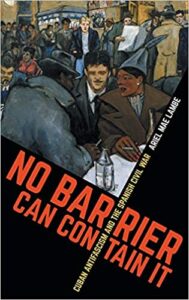Book Review: Cuban Antifascism and the Spanish Civil War
 No Barrier Can Contain It: Cuban Antifascism and the Spanish Civil War, by Ariel Mae Lambe. University of North Carolina Press, 2019. 310 + xvi pp.
No Barrier Can Contain It: Cuban Antifascism and the Spanish Civil War, by Ariel Mae Lambe. University of North Carolina Press, 2019. 310 + xvi pp.
Cuba sent more volunteers to defend the Spanish Republic between 1936 and 1939 than any other Latin American country – about 1,000 people. That number was a much higher proportion by population than the 3,000 who came from the United States and about ten times as many as from Mexico, whose government was the only in Latin America to support the Republicans. The scale of Cuban involvement reflects the deep resonance of the Spanish antifascist struggle in Cuba at the time. Ariel Mae Lambe’s No Barrier Can Contain It explores the origins and impacts of antifascism in Cuba, stressing the importance of the Spanish struggle for domestic Cuban politics.
Lambe’s focus is on the period 1934-1940, which began with a right-wing military coup by Fulgencio Batista and ended with Batista’s election and the enactment of a surprisingly progressive Constitution in 1940. Lambe counters the view of many scholars that Batista’s crushing of a 1935 general strike led to dormancy and demoralization on the left. Instead, progressive Cubans shifted their focus to the international level. They drew parallels between European fascism and the dictatorship, repression, and U.S. imperialism they faced at home, seeing “antifascism as a continuation of their fight for a new Cuba.” As they sent soldiers, support personnel, and material donations to Spain, they kept alive their hopes for a “New Cuba.”
The Spanish cause inspired such solidarity largely because of Cuba’s close historic ties to Spain, which had colonized the island until 1898. Cuban antifascists associated their own quest for a New Cuba with progressive Spaniards’ fight for a “New Spain.” A common language and the presence of Spanish emigres in Cuba facilitated communication. Unfortunately, Ethiopians had garnered somewhat less solidarity when Mussolini invaded their country in October 1935. Whereas the Spanish cause eventually drew broad support in Cuba, outrage over Ethiopia was limited to a smaller circle of Black Cuban activists and non-Black leftists. Several factors seem to explain this difference: the lack of migrant networks connecting Cuba and Ethiopia, the fact that Ethiopia was conquered more quickly, and the implicit racism that led to more concern for a European people.
Lambe’s chapter on the volunteers who went to Spain examines their motives, the means of recruitment, and the political uses of martyrdom. Most were recruited by the Cuban Communist Party, though not all were party members. Lambe devotes special attention to one prominent Cuban activist, Pablo de la Torriente Brau, who was killed on the battlefield in December 1936 and posthumously heralded as a martyr by the Cuban left. Here I wanted more detail on the demographics of the Cuban volunteers: their racial composition, their class, their urban versus rural origins, and so on. It seems like most volunteers came from the cities. But rural Cubans also had a tradition of militancy, as exemplified by the 1933 insurgency when workers had occupied dozens of sugar mills and plantations. I imagine the sources did not allow Lambe to be more specific.
The following chapter offers a more detailed portrait of participation in the donation drives organized by Cuban antifascists, including Torriente’s widow Teresa “Teté” Casuso. In contrast to the volunteers who fought in Spain, Casuso and other organizers billed the donation campaign as a nonpartisan work of charity. That framing elided the nature of the opposing forces in the war, but it may have helped the campaign attract more contributions from “moderate” Cubans. Lambe uses financial records to show that donations of money, food, and clothing were very widespread across the island. A broad swath of Cuban society showed concern for Spain, at least enough to donate.
The ideological diversity of Cuban antifascism is a recurring theme throughout the book. The anticommunist Casuso symbolized the more centrist members of the coalition, which also included Free Masons and a wide range of other non-left organizations. The multifarious Cuban left was itself composed of anarchists, Communists, Trotskyists, and others. Despite plenty of conflict among these latter groups, Lambe argues that antifascism was a powerful unifying force that tempered the left’s tendency toward internal division.
By the end of the decade, the antifascism initially spearheaded by leftists had spread to include more and more sectors of society. The opportunistic Batista came to see the political benefits of embracing antifascism. To win over working-class voters he also agreed to allow modest social reforms and a relatively progressive constitution. His surprising alliance with the Communist Party, which he had previously outlawed, helped deliver him the 1940 election. In return for new freedoms the party leaders moderated their own platform, as most Communist parties of the Popular Front era did. In contrast with many prior accounts, Lambe’s interpretation of the Batista-Communist alliance stresses Batista’s vulnerability, the political power of Cuban antifascism, and the role of transnational politics in shaping domestic Cuban developments.
No Barrier Can Contain It is an important contribution to Cuban history and to our understanding of the Civil War’s global reverberations. Its emphasis on the relationship between transnational antifascism and domestic political struggle is novel and raises questions for future research on the Civil War years in other countries.
Kevin A. Young is an Associate Professor of History at the University of Massachusetts Amherst. He is the author of among other works Blood of the Earth: Resource Nationalism, Revolution, and Empire in Bolivia (2017) and most recently a co-author with Tarun Banerjee and Michael Schwartz of Levers of Power: How the 1% Rules and What the 99% Can Do About It (2020).












